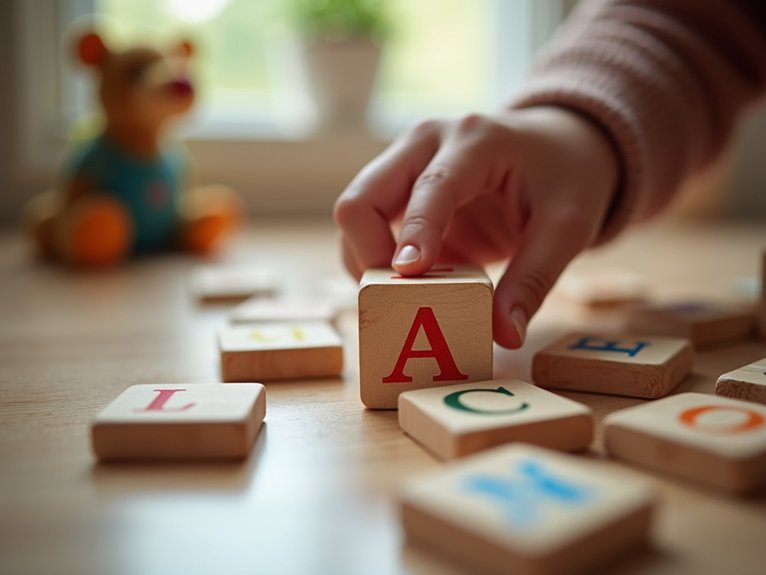Learning the alphabet becomes effective when made enjoyable through play. Parents can incorporate letters into daily routines by pointing out signs, labels, and creating scavenger hunts. Multisensory approaches engage children through touch, sight, and sound with activities like forming letters with clay or singing alphabet songs. Creating a print-rich home environment with labeled items, books, and magnetic letters reinforces recognition. Technology offers supplemental learning through quality educational apps. These strategies establish strong foundations for early literacy development.
Making Alphabet Learning Fun Through Play-Based Activities

Five effective play-based activities can transform alphabet learning from a mundane task into an engaging experience for young children. Alphabet scavenger hunts encourage letter recognition in everyday environments. Sensory bins filled with rice or sand allow children to physically dig for and identify letters.
Letter-themed crafts, such as creating animals that start with specific letters, reinforce sound-symbol connections. Alphabet movement games, where children form letters with their bodies, incorporate physical activity with learning. Finally, cooking activities using alphabet-shaped foods create memorable associations while developing fine motor skills alongside literacy.
Multisensory Approaches to Letter Recognition
Why do multisensory approaches prove so effective in helping children recognize letters? Research shows that engaging multiple senses simultaneously creates stronger neural pathways, enhancing memory retention and learning.
Tactile methods include tracing sandpaper letters, forming shapes with clay, or finger-painting letterforms. Visual strategies incorporate colorful flashcards, picture associations, and environmental print. Auditory techniques involve letter sounds, songs, and rhymes that reinforce phonetic connections.
Kinesthetic activities like forming letters with body movements or walking along letter shapes on the floor help active learners. For maximum effectiveness, parents should combine these approaches based on their child’s learning preferences.
Incorporating Letters Into Your Daily Routine

Ordinary household activities provide countless opportunities to incorporate alphabet learning naturally throughout a child’s day. Parents can point out letters on food packaging, street signs, and store logos during errands or mealtimes.
While cooking, ask children to find ingredients beginning with specific letters. During bath time, use foam letters or write on shower walls with washable markers. Create a letter scavenger hunt during cleanup time.
Car rides become educational when playing alphabet games like spotting objects beginning with sequential letters. These routine integrations help children understand that letters exist beyond formal learning settings and serve practical communication purposes in everyday life.
Creating a Print-Rich Environment at Home
A print-rich environment surrounds children with meaningful text and visual representations of letters, creating natural opportunities for alphabet learning.
Parents can label household items with clearly written words, display alphabet posters at child-level height, and stock bookshelves with diverse reading materials. Magnetic letters on refrigerators, alphabet blocks, and letter puzzles provide tactile engagement while reinforcing letter recognition.
The environment should include functional text examples—grocery lists, calendars, and notes—demonstrating how letters serve real purposes. Rotating materials keeps the environment fresh and engaging. Even digital devices can supplement learning with high-quality alphabet apps and interactive stories when used mindfully.
Using Technology and Apps as Learning Tools

The judicious integration of technology offers powerful tools for alphabet learning when used appropriately. Educational apps featuring interactive letter recognition, phonetic sounds, and tracing activities can reinforce concepts introduced through traditional methods.
Parents should select high-quality applications with developmentally appropriate content, limited advertisements, and meaningful engagement rather than passive consumption. Experts recommend setting time limits and participating alongside children to facilitate connections between digital and real-world learning.
Video conferencing tools can also connect children with distant family members for virtual alphabet practice sessions, creating additional opportunities for meaningful letter recognition and pronunciation reinforcement within supportive relationships.



